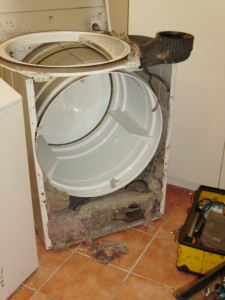Laundry Maintenance
Looking after your guest laundry or laundromat means more than just collecting the coins and giving the machines a quick wipe over although that is a good start. It doesn’t matter weather it is Speed Queen, Maytag, Whirlpool, Heubsch, Uniamc, or GE you eventually buy or inherite, (if it is an old laundry) they all need to be looked after. All your laundromat equipment needs preventative maintenance in order to protect your business, your machines, and your profits. Actually my first maintenance starts on the day they are installed. My first action is to take off the front panel and give the machines a good spray of Fish oil around all the seems and welded joints.Be very careful not to spray near the belts and pulleys or near the damper assembly on the top loaders. Although the new machines are protected against rust doing this will add years to the life of the machines particularly washing machines. Giving the external paint work and particularly the chrome coin box and coin slide a polish with some good quality car polish will keep the machines looking good for years longer.Doing proper laundromat maintenance also ensures your employees and your customers a clean, safe, and efficient store.
I hope to add further information on this website which may include videos of maintenance and basic repairs to help you along so if you do own and run your own laundomat or guest laundry this may prevent to many service call expenses.
Here are the basics of maintaining each system within your laundromat.
Washing Machine Maintenance
Washers are basically a big tub that fills with water and soap, while an agitator moves back and forth in the middle of the tub. Front-load washers do not have the agitator and instead use gravity in a tumbling action to separate dirt from clothes.
Replace and clean the water filter inlet screen regularly. These screens build up with sand and grit from in the water supply. Check the drain pipes and traps for a build of lint and sludge.
Use a washing machine cleaner to remove soap and dirt residue buildup inside the drum. This may also improve the appearance of the machine for customers.
Regularly check hoses, connections, and joints for leaks. A broken hose is the most common cause of flooding in laundromats.
Occasionally belts will wear out and need to be replaced. Belts connect the motor to the washer drum. These can be replaced based upon a preset time or cycle period. Often a bi-annual visual inspection is all that’s needed to ensure a belt isn’t frayed and about to snap.
Dryers represent the most common cause of fires and property damage within a laundromat because they operate at extremely high temperatures. The most common cause of dryer fires is accumulated lint on the lint screen, in the ducting and within the cabinet of the dryer. When this material collects it constricts the flow of hot air out of the dryer, which in turn increases the chance of a fire. To prevent this situation, implement a daily lint cleaning routine. Other causes of dryer malfunction or dryer fire are: improper installation (typically hoses and ducts), buildup of oils from clothing and rags in the laundry, and insufficient air flow through the dryer. So every six months the front panel of the dryer should be removed, checked inside and cleaned if necessary.
Coin Slides
The biggest area for maintenance in a coin laundry is the Coin Slides with coin jams and attempts of theft. A small amount of WD40 sprayed around the slide part of the mechanism seem to keep the slide running smoothly and also polishes the chrome. I will go into coin slide repairs in a further article.

Comments on this entry are closed.